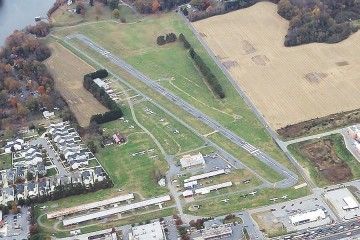Skip to content
By Brad Dress
Before the plane could fly out of Lee Airport, pilot Bill Friday had a lot to check.
Are we clear for runway? Is this dial in the off position? Is the crossfeed on?
I sat in the back of the 4,000-pound light aircraft — the Federal Aviation Administration’s name for a small airplane that typically seats six or fewer people — trying to scribble down everything being said.
It proved an impossible task.
Friday’s instructor kept adding more to the list. In the dusty cockpit, the president of the Navy Annapolis Flight School, Frank Kennedy, insisted Friday read the dials correctly.
“Come on, read it,” Kennedy said. “You know better than this.”
Kennedy couldn’t do without Lee Airport, the main base of operations for a flight school that trains at least 30 students a year to become licensed pilots, whether private or commercial.
Lee is one of Maryland’s 35 surviving community airports. For years, such airports “formed the backbone of the aviation network,” as the Baltimore Sun reported in 1995.
Generations of future pilots trained at such airports. Still do at Lee Airport. Businesses, politicians and flight junkies rely on it for private transportation. Emergency responders use it for medevacs.
“You don’t have another airport nearby,” said Kennedy. “You absolutely want that in the community.” Its Edgewater location puts it in the backyard of the state capital, Annapolis.
But community airports are one more institution threatened by changing times and technologies. At least five community airports have closed since 1985, according to the Maryland Aviation Administration.
From Tobacco Fields to Airfields
The world looks much different from 800 feet in the air. Cars and houses are miniature, but the depth and beauty of nature seems richer. Details can be picked out, such as the twisted shapes of hills and the smooth geography of the Bay.
You can also feel every slight movement of the plane.
“If you’re not nervous in an airplane, there’s something wrong with you,” Kennedy reminded me as I clutched a “pilot relief bag” and hoped I didn’t have to use it.
At a thousand feet, I was stable enough to ask more about the flight school through our radio headsets.
When Friday retired from the Coast Guard as a helicopter pilot, he wanted to get his commercial license to fly bigger planes. To do that, he needs 250 hours of training at Lee Airport. Friday pays $280 an hour to train. It’s a passion for him, and he can’t escape it.
“The thrill of being airborne, being able to see the world from a different perspective,” Friday said, “is almost like being a bird.”
Kennedy, his mentor, has been a pilot for 60 years, flying for both the military and aviation industry. His school doesn’t make a huge profit. But, he says, teaching the next generation of pilots “is not a monetary issue, it’s a passion.”
“It’s how every species survives,” Kennedy added. “If the adults don’t teach the children, what happens?” 
It’s this question that worries Van Lee, the owner of the 79-acre Lee Airport where Kennedy’s flight school and other pilots rent their space. Anyone registered with the Federal Aviation Administration can lease a spot at the airport for roughly $90 a month. The planes must be light aircraft, generally small planes under 12,000 pounds.
Lee, who is not a pilot, calls his family business “the unofficial airport of the capital of Maryland. It serves the purpose of freedom, from hobby to business.”
The airport pays for itself, he said, but it does not make a profit. In 2000, 115 planes were registered at the airport; now there are 76.
Lee Airport is an artifact of changing times. The Lee family created it in 1939, converting it from a less-profitable tobacco field. (It was leased by the Parlett family from 1956 to 2000, when Van Lee took over management.) Over 80 years, Edgewater’s open land has been developed as a suburban commmunity. The airport and denser community have managed to coexist.
The Capital Gazette has documented a handful of crashes since 1985.
In 1988, a community covenant limited the number of flight hours and planes. In 2006, two crashes caused fatalities near Lee Airport.
The FAA found the airport was not at fault and continues to defend community airports.
“Small airports are not unsafe,” said Maryland Aviation Administration spokesman Shane Goad. “As with large airports, the pilot is the final authority in ensuring safe flight.”
Longtime pilots such as Kennedy agree.
“Up here, there’s not a bunch of dummies running red lights,” he explained.
Lee Airport also has Anne Arundel County’s support.
“Lee Airport has a useful role to play in the county, both in terms of recreation and general aviation education,” said chief administrative officer Ben Birge.
Edgewater continues to grow, and a developed commercial district now surrounds the airport. But light aircraft continue to zoom in and out of Lee Airport, sometimes startling drivers on busy Rt. 2.
One More Safe Landing
The Geronimo aircraft swooped and headed back home, floating through puffy clouds and the ice-blue sky. Below, there seemed more water than land.
The plane cut back to 800 feet, then 500, before Lee Airport’s 2,500-foot runway appeared.
The school is flying students out nearly every day, and private pilots like William Rynone, who has flown out of Lee Airport since the 1980s, plan to stay.
“We need more airports, not less,” Rynone argued.
The times may be trending in Lee’s favor. No small airport has closed in 15 years, noted Shane Goad of Maryland Aviation. New technologies such as drones, could propel a future for aviation related business.
Meanwhile, owner Van Lee is enjoying what he has.
“It’s fascinating to look at airplanes,” he said. “They’re such a small part of our country, but so wonderful.”

